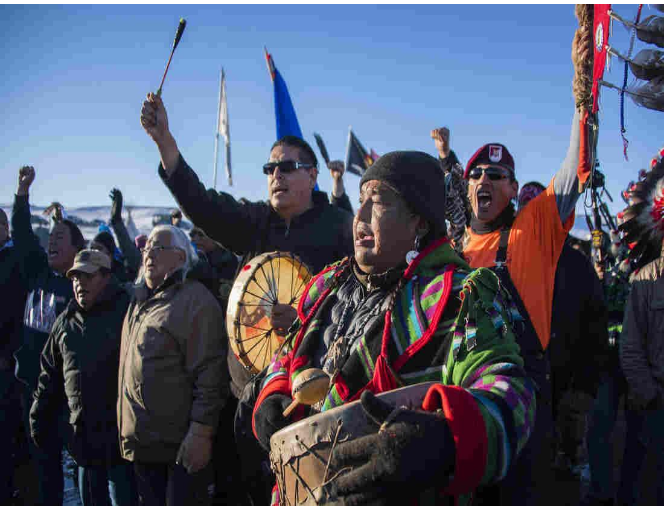
If you haven’t heard of the Dakota Access Pipeline and the protests at the Standing Rock reservation by now, here’s a quick synopsis:
The Dakota Access Pipeline, or Bakken Pipeline, is being constructed primarily by Energy Transfer Partners (also known as Dakota Access, LLC), along with Philips 66, Enbridge, and Marathon Petroleum. These companies are spending 3.78 billion to construct the pipe as a faster, cheaper way to transport oil. Standing Rock Sioux tribe members, who identify as “water protectors” and “land defenders” have been leading the action against the pipeline due to its potential harm to the water supply and land, eminent domain of the land under the 1851 Treaty of Fort Laramie, and on the basis that sacred burial grounds and lands would be dug up for its construction. The tribe asked for a temporary injunction and was denied last September by a federal judge. The Standing Rock Sioux and their supporters (also known as the Camp of the Sacred Stones) have since been engaged in peaceful demonstrations, and have experienced arrests, as well as the use of water cannons at below freezing temperatures, beanbag rounds, tasers, and tear gas. Earlier this December, President Obama and the U.S. Army Corps of Engineers denied the easement needed to complete construction of the pipeline. The Camp of Sacred Stones has indicated that this is a step in the right direction, but that the fight is far from over.
via Scott Olson/Getty Images
So, why should you support action against the Dakota Access Pipeline? Here’s a list of 3 important reasons, and why.
Water is life.
Even your average fifth grader can tell you that water is one of the five main things that living organisms need to survive and thrive. The significance of this, however, often seems to go unrecognized. As the earth’s population has increased, its water supply has stayed the same, and globally, we are experiencing a freshwater crisis. National Geographic cites the United Nations in stating that “water use has grown at more than twice the rate of population increase in the last century. By 2025, an estimated 1.8 billion people will live in areas plagued by water scarcity, with two-thirds of the world’s population living in water-stressed regions as a result of use, growth, and climate change.” We human beings are very, very inefficient water users and often contaminate the water we do have. Pipeline spills have been more frequent in recent years and the efforts of the Sacred Stones camp to protect the Missouri River is in line with the global need for water conservation.
Just days after the easement was denied, CNBC reported that a pipeline leak from the DAPL spilled 176,000 gallons of crude oil into a creek just 150 miles from the Camp of the Sacred Stones.
If it’s Not Okay for the Residents of Bismark, It Shouldn’t be Okay for the Standing Rock Sioux.
At first, the pipeline was supposed to cross the Missouri River ten miles north of Bismark. The U.S. Army Corps of Engineers evaluated the route and determined that it was unsuitable for various reasons, including that a pipeline spill could have severe consequences in contaminating Bismark’s water supply. The pipeline was then rerouted to a half-mile north of the Standing Rock Sioux Reservation.
This goes without saying, but if possible contamination of Bismark’s water supply is unacceptable for the U.S. Army Corps of Engineers, it should also be unacceptable for the members of the Standing Rock Sioux reservation and other communities living downstream. When resources like freshwater are scarce or threatened, certain populations that are deemed “less valuable” within societal structures (like the residents of Flint, Michigan who to date still do not have clean water) are affected more harshly than others.
French social theorist Michel Foucault discusses “biopower” to examine the way that modern nations use “numerous and diverse techniques for achieving the subjugations of bodies and the control of populations.” Within The History of Sexuality, he suggests the system in which modern nations regulate their subjects is by way of the idea “to make live and let die” (which is different from medieval systems of rule, where a monarch had the control to “let live and make die”). The ideas of “biopower” and to “let die” are well-exemplified by the AIDS crisis, when the inaction of President Reagan and the American government effectively “let die” thousands of gay men.
Water is life. When populations like the Standing Rock community do not get their basic needs – like water – met and/or actively prevented from doing so, we are in essence participating in “letting die.” Sure, it may not be that cartoony sort of death where people drink poison, seize up, and keel over with Xs in their eyes, but consider the long-term impacts on mental and physical health and quality of life when not a clean water supply is not available. It is the slow killing of social “undesirables” through the democratic flow of power.
Continuation of Native American Genocide and Cultural Erasure
America has had a troubled history with Native Americans, to put it lightly. In the 19th and 20th centuries, white settlers and the American government engaged in a policy of broken treaties, killings, theft, and slavery that left millions of Native Americans displaced and dead. Lenore A. Stiffarm and Phil Lane, Jr. have stated that “there can be no more monumental example of sustained genocide—certainly none involving a ‘race’ of people as broad and complex as this—anywhere in the annals of human history.”
Bill McKibben of the New Yorker makes a parallel of this history to current events, stating that they “run to the original sins of this nation. The reservation, of course, is where the Native Americans were told to live when the vast lands they ranged were taken by others… In the nineteen-fifties and early sixties, the Army Corps of Engineers—the same Army Corps now approving the pipeline—built five large dams along the Missouri, forcing Indian villages to relocate. More than two hundred thousand acres disappeared beneath the water.”
Though camp inhabitants have engaged in peaceful protest, they have again, as in America’s larger past, been met with acts of physical violence that convey a sense of disregard for Native American life and culture in the face of capital gain. Bulldozers have already encroached on some burial grounds, and further construction would result in the desecration of more sacred sites. The Sacred Stones camp has pointed to violations in Article 2 of the 1868 Fort Laramie Treaty “which guarantees that the Standing Rock Sioux Tribe shall enjoy the ‘undisturbed use and occupation’ of [the Standing Rock Sioux Tribe’s] permanent homeland, the Standing Rock Indian Reservation.” (Standing Rock itself has had a sad history of broken treaties with the American government.)
On one hand, the construction of the Dakota Access Pipeline may simply seem like a way for Americans to buy cheaper gas at $2 a gallon. Upon closer examination, however, the standoff between the U.S. Army Corps and the Standing Rock Sioux is indicative of a truly American mindset in which Native American lives are substandard to capital gain (especially as our own President-Elect, Donald Trump, has investments tied into the DAPL). This event is a modernized extension of an ages-old genocide, and an active part of cultural erasure. History has quickly become our present, and will continue to be a part our future if we allow the Standing Rock Sioux and other tribes be “let die.”
To support the efforts of the Camp of Sacred Stones, please visit:
standwithstandingrock.net
ocetisakowincamp.org
waterprotectorlegal.org
Author: by Nina Ki
Images: Scott Oslon/Getty Images



